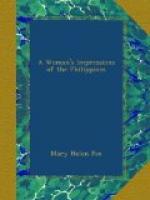The engineer was not able to keep his dire threat about the lorcha’s nose, but it is only just to say that he tried to. We met a heavy sea outside of Corregidor, and never have I seen anything more dizzy and drunken and pathetic than the rolls and heaves of the lorcha.
At Iloilo we met the army transport McClellan, and continued our voyage upon her to Capiz. We bade farewell to her with regret, and consumed in an anticipatory passion of renunciation our last meal with ice water, fresh butter, and fresh beef. The McClellan took away the troops of the Sixth Infantry and the Tenth Cavalry, and left us, in their stead, a detachment of the Ninth Cavalry, which remained perhaps two months, and was then stationed at Iloilo, leaving us with nothing but a troop of native voluntarios, or scouts, officered by Americans, and a small detachment of native constabulary. We had barely accustomed ourselves to this, and ceased to predict insurrection and massacre, when the cholera, which we had hoped to avoid, descended upon us.
I am sorry that I can relate no deeds of personal heroism or of self-sacrifice in the epidemic. There didn’t seem to be any place for them, and I am not certain that I knew how to be heroic and self-sacrificing. I was not, however, so nervous about the cholera as some Americans were, and I like to convince myself that if any of my friends had sickened with it and needed me, I should have gone unhesitatingly and nursed them. Fortunately (or unfortunately for the proof of my valor) this was not the case. The scourge stayed with us between two and three months. The highest mortality was between a hundred and a hundred and fifty deaths a day, and by its ravages Capiz was reduced from a first-class city of twenty-five thousand inhabitants to a second-class city of less than twenty thousand. I kept a brief record, however, of our experiences during that time, and once again, by permission of The Times, insert them here.
September 8. Miss P——, Dr. B——, and I were out for a long walk this afternoon. They left me at my door just as Mrs. L—— and Mrs. T—— drove up in the latter’s victoria. Both ladies were much excited by the news that a parao had landed at the playa with one dead man and a case of cholera still living. The other people of the parao had scattered before the health officers got hold of the matter.
September 9. The story about the parao has been confirmed. We had hoped to escape the epidemic, but are in for it now, for certain.
September 10. It is rumored that two cases of cholera developed yesterday. Dr. B—— denies it, says they are nothing but acute dysentery. Dr. S—— thinks they are cholera.
September 11. Whatever this illness be, it kills people in a very short time. A little public-school boy was taken sick last night, and died in three or four hours. Natives are terribly frightened, and we Americans are far from comfortable.




